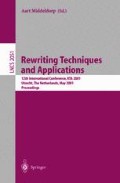Abstract
We present the titular proof development which has been implemented in Isabelle/HOL. As a first, the proof is conducted exclusively by the primitive induction principles of the standard syntax and the considered reduction relations: the naive way, so to speak. Curiously, the Barendregt Variable Convention takes on a central technical role in the proof. We also show (i) that our presentation coincides with Curry’s and Hindley’s when terms are considered equal up-to α and (ii) that the con uence properties of all considered calculi are equivalent.
Supported under EU TMR grant # ERBFMRXCT-980170: LINEAR. Work done in part while visiting LFCS, University of Edinburgh from Heriot-Watt University.
Supported by a grant from LFCS, University of Edinburgh.
Access this chapter
Tax calculation will be finalised at checkout
Purchases are for personal use only
Preview
Unable to display preview. Download preview PDF.
References
Barendregt: The Lambda Calculus — Syntax and Semantics. North-Holland, 1984.
Burstall: Proving properties of programs by struct. ind. Comp.J., 12, 1967.
Curry, Feys: Combinatory Logic. North-Holland, 1958.
de Bruijn: Lambda calculus notation with nameless dummies, a tool for auto. formula manipulation, with appl. to the CR Theorem. Indag. Math., 34, 1972.
Despeyroux, Hirschowitz: HOAS with ind. in COQ. LPAR, 1994. LNAI 822.
Despeyroux, Pfenning, Schürmann: Prim. rec. for HOAS. TLCA, 1997. LNCS 1210.
Fiore, Plotkin, Turi: Abstract syntax and variable binding. In Longo [16].
Gabbay, Pitts: A new approach to abstract syntax involving binders. In Longo [16].
Girard: From the rules of logic to the logic of rules. To appear in MSCS.
Gordon, Melham: Five axioms of alpha-conversion. TPHOL, 1996. PLNCS 1125.
Hindley: The CR Prop. and a Result in Comb. Logic. PhD thesis, Newcastle, 1964.
Hofmann: Semantical analysis of HOAS. In Longo [16].
Huet: Residual theory in λ-calculus: A formal development. JFP, 4(3), 1994.
Jouannaud, Kirchner: Compl. of a set of rules mod. a set of eq. SIAM, 15, 1986.
Klop: Combinatory Reduction Systems. Mathematical Centre Tracts 127, 1980.
Longo (ed.): LICS-14, 1999. IEEE Computer Society Press.
McKinna, Pollack: Some lambda calculus and TT formalized. To appear in JAR.
Nipkow: More CR proofs (in Isabelle/HOL). CADE-13, 1996. LNCS 1104.
Rose: Explicit substitution–tutorial & survey. BRICS-LS-96-13, 1996.
Rutten: A calc. of transition systems (towards univ. coalg.). CWI-CS-R9503, 1995.
David E. Schroer. The Church-Rosser theorem. PhD thesis, Cornell, June 1965.
Schürmann: Automating the Meta Theory of Ded. Syst. PhD thesis, CMU, 2000.
Shankar: A mechanical proof of the Church-Rosser Theorem. J. ACM, 35(3), 1988.
Takahashi: Parallel reductions in λ-calculus. I. and C., 118, 1995.
Author information
Authors and Affiliations
Editor information
Editors and Affiliations
Rights and permissions
Copyright information
© 2001 Springer-Verlag Berlin Heidelberg
About this paper
Cite this paper
Vestergaard, R., Brotherston, J. (2001). A Formalised First-Order Con uence Proof for the λ-Calculus Using One-Sorted Variable Names (Barendregt Was Right after all ... almost). In: Middeldorp, A. (eds) Rewriting Techniques and Applications. RTA 2001. Lecture Notes in Computer Science, vol 2051. Springer, Berlin, Heidelberg. https://doi.org/10.1007/3-540-45127-7_23
Download citation
DOI: https://doi.org/10.1007/3-540-45127-7_23
Published:
Publisher Name: Springer, Berlin, Heidelberg
Print ISBN: 978-3-540-42117-7
Online ISBN: 978-3-540-45127-3
eBook Packages: Springer Book Archive

